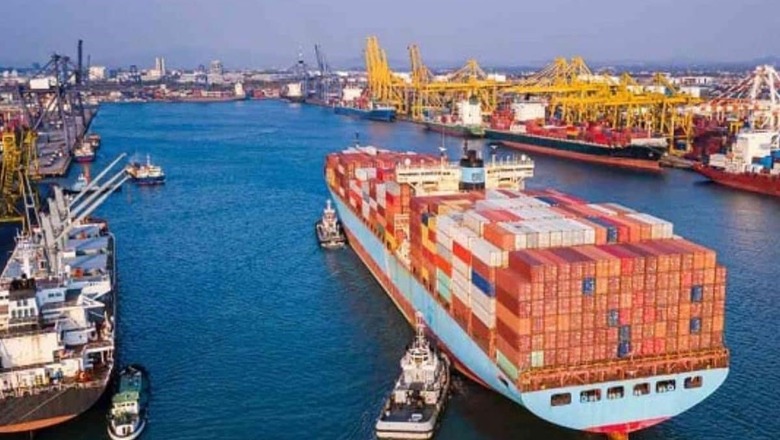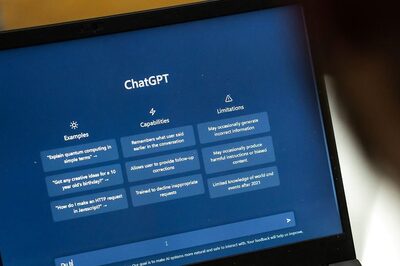
views
India aims to develop six mega ports by 2047 as part of its ambitious maritime expansion plans, significantly increasing its cargo handling capacity outlined in the Amrit Kaal Vision 2047. The government expects these mega ports to crucially enhance India’s maritime trade, streamline cargo movement, and generate new job prospects. This initiative represents a significant stride in India’s maritime aspirations, positioning the nation as a key player in global trade. The project’s success hinges on efficient execution, attracting private investment and implementing sustainable development practices.
Announced under the Maritime Amrit Kaal Vision 2047, port development will focus on two categories:
Capacity Exceeding 500 Million Tonnes Per Annum
- Deendayal and Tuna Tekra Port Cluster
- Jawaharlal Nehru – Vadhavan Port Cluster
Capacity Exceeding 300 Million Tonnes Per Annum
- Cochin – Vizhinjam Port Cluster
- Galathea South Bay Port
- Chennai – Kamarajar – Cuddalore Port Cluster
- Paradip and Other Non-Major Ports Cluster
As India embarks on its journey towards maritime expansion with the development of six mega ports, the Maritime Amrit Kaal Vision 2047 emerges as the guiding light, symbolising the nation’s commitment to harnessing its coastal potential. At the Global Maritime India Summit 2023, this vision was unveiled, paving the way for a transformative era in India’s maritime sector with unprecedented investments and strategic initiatives.
Maritime Amrit Kaal Vision 2047
During the Global Maritime India Summit 2023, a comprehensive roadmap was launched, marking a transformation in India’s maritime sector and involving an investment of Rs 80,000 lakh crore. The country’s maritime sector, which includes 12 major ports and over 200 non-major ports along the 7,500 km coastal line, significantly contributes to the growth of the country’s economy. The Government of India has highlighted “Blue Economy” as one of the 10 core dimensions of economic growth in its vision for 2030. The Ministry of Ports, Shipping & Waterways formulated the Amrit Kaal Vision 2047, building on the Maritime India Vision 2030, which aims to develop world-class ports and promote inland water transport, coastal shipping, and a sustainable maritime sector.
The preparation of the Amrit Kaal Vision 2047 for logistics, infrastructure and shipping (including transshipments) cluster was driven by the following key principles:
- Assessment of the current landscape for identification of gaps and finding actionable points to fill in the gaps for achieving the respective targets.
- Analysis of international best practices across infrastructure, capacity building, institutional framework and regulatory environment for developing the actionable points.
- Developing a framework for improving innovation and financing in the maritime sector.
- Driving the agenda for promoting Aatmanirbhar Bharat and sustainability in the maritime sector.
- Defining the timeline for the implementation of the actionable points.
The Amrit Kaal Vision 2047 Action Points have been defined across 11 key themes which are provided below. A total of 300+ initiatives along with their action plan have been identified across these themes:
- Develop World Class Next Generation Ports: India’s coastline and sea islands host 12 major ports and over 200 non-major ports crucial for facilitating EXIM and coastal trade, handling over 1319.97 million tonnes of cargo in 2019-20. Under the Amrit Kaal Vision 2047, 42 initiatives aim to develop world-class next-generation ports. Key initiatives include creating port clusters, deepening drafts, establishing transhipment hubs, building two new major ports, reducing vessel charges, and increasing private sector participation through projects like PM Gati Shakti – NMP and Asset Monetization Plan. The development of six mega ports with capacities exceeding 300 and 500 million tonnes per annum (MTPA) is part of this initiative.
- Lead The World In Safe, Sustainable & Green Maritime Sector: The Government of India aims to reduce maritime sector emissions in line with global targets, promoting zero and low-emission solutions. Major ports are adopting solar and wind energy, while the shipping sector is transitioning to alternative fuels like LNG and batteries. Under the Amrit Kaal Vision 2047, key initiatives include making major ports carbon-neutral, launching pilot projects for green shipping, and providing incentives for low-carbon vessels and technology development.
- Promote Ocean, Coastal & River Cruise Sector: India’s maritime tourism sector faces barriers hindering growth in both the cruise and ferry industries. To attract tourists and cruise lines, a stable regulatory framework aligned with international standards is crucial. Under the Amrit Kaal Vision 2047, initiatives include developing cruise terminals, relaxing cabotage rules, extending e-visa facilities, providing fiscal incentives, and capacity building through training academies.
- Enhance Modal Share of Coastal Shipping & Inland Water Transport: India’s coastal shipping and inland waterways sector remains underdeveloped compared to other modes of transport, despite its cost-effectiveness and environmental benefits. To enhance modal share, key initiatives under the Amrit Kaal Vision 2047 include creating port-based agglomeration centres, coastal berths near production centres, improving connectivity, reducing port dues and terminal charges, providing fiscal incentives, operationalising 50 waterways by 2047, and introducing low draft vessel designs.
- Promote Maritime Clusters: Under the Amrit Kaal Vision 2047 Action Plan, maritime clusters are to be established along ports and at Andaman and Nicobar Islands. Key initiatives include collaborating with the private sector to develop these clusters, identifying focus commodities and implementing investor-friendly policies. Additionally, three islands, including Greater Nicobar & Port Blair and Kalpeni Island are earmarked for development as bunkering hubs, ship repair centres, and vessel spares and stores facilities. The initiatives encompass infrastructure, institutional, and policy/regulatory developments to achieve these objectives.
- Provide Maritime Professional Services: As India’s maritime industry expands, additional capital and fiscal incentives are needed. To address financing challenges, a maritime development fund is proposed to provide low-cost, long-term capital. Additionally, initiatives include establishing an international maritime arbitration centre, expediting insurance claim settlements, and providing fiscal incentives through direct and indirect taxes. These measures aim to promote ease of financing and enhance professional services in the maritime sector.
- Become a Global Player in Shipbuilding, Repair & Recycling: India aims to strengthen its shipbuilding, repair, and recycling industry by implementing a mix of fiscal and non-fiscal incentives. The Amrit Kaal Vision 2047 Action Plan outlines 17 initiatives, including extending the shipbuilding policy, promoting Aatmanirbhar Bharat provisions, grading shipyards, simplifying customs procedures, expanding Alang Shipyard, and developing new ship recycling locations. These measures are designed to propel India towards leadership in the global shipbuilding industry.
- Develop World Class Education, Research & Training Facilities: India’s maritime education and research ecosystem currently operates independently, lacking a unified platform for collaboration. To drive innovation in the maritime sector, the Amrit Kaal Vision 2047 identifies 39 initiatives, primarily focusing on creating an innovation ecosystem. Key initiatives include setting up incubators and accelerators, establishing Maritime Knowledge Clusters for collaborative research, creating centres of excellence for logistics, forming partnerships with international training institutes, standardising port tariffs, and reducing professorship tenure at maritime institutes.
- Strengthen India’s Global Maritime Presence: Enhancing maritime cooperation is vital for India’s global maritime leadership. Under the Amrit Kaal Vision 2047, 43 initiatives are outlined, with a focus on strengthening India’s global maritime presence. Key initiatives include establishing a dedicated IMO cell, appointing a permanent representative at IMO headquarters in London, implementing the BIMSTEC Master Plan, and creating a robust institutional structure for BIMSTEC to ensure timely project implementation.
- Enhance Efficiency Through Technology & Innovation: The maritime sector, handling around 90 per cent of international cargo volume, has embraced technology to enhance efficiency, reduce costs, and streamline operations. The Covid-19 crisis emphasised the importance of digitalisation in global maritime supply chains, prompting India to improve its technological innovation and integration. Under the Amrit Kaal Vision 2047, 17 initiatives focus on implementing technology advancements such as E-gate 2.0, drone-based inventory management, just-in-time systems, automation of harbour cranes, digital twin for port planning, advanced analytics-based yard management, automated berth allotment, and establishing a digital centre of excellence for research and implementation of upcoming technologies.
- Enhance India’s Tonnage: India’s growth in shipping tonnage has lagged behind trade needs, with its fleet share at only around 1 per cent compared to leading nations like China and Singapore. To address this, the Amrit Kaal Vision 2047 outlines nine initiatives aimed at improving India’s tonnage share. Key initiatives include providing fiscal incentives like revisiting TDS applicability on seafarer wages, allowing input tax credit on fuel and spares, exempting Indian ships from GST on MRO services abroad, granting infrastructure status to the shipping industry, facilitating alternative financing sources, and removing restrictions on ship leasing by insurance companies.
Maritime Roadmap 2047
From 2014 to 2023, the fleet of ships sailing under the Indian flag expanded from 1,205 to 1,526, demonstrating the country’s commitment to bolstering its maritime presence. This growth was accompanied by a significant increase in gross tonnage, which rose from 10.3 million in 2014 to 13.7 million in 2023, showcasing the enhanced capacity and scale of operations. Furthermore, the number of Indian seafarers surged from 1,17,090 in 2014 to an impressive 2,50,071 in 2022, marking a remarkable increase of nearly 114 per cent in just nine years.
The remarkable growth in India’s maritime fleet and seafarer numbers from 2014 to 2023 underscores the nation’s steadfast commitment to maritime advancement. As India’s maritime presence strengthens, Amrit Kaal 2047 charts a bold course toward further development and expansion, with a focus on transforming port infrastructure and bolstering capacity to meet the demands of a rapidly evolving global trade landscape.
The development of world-class major ports stands at the forefront of India’s ambitious maritime vision. Presently, the nation’s port handling capacity exceeds 2,500 MMTPA, with 51 per cent of cargo handled at PPP berths of major ports. The focus is on enhancing this infrastructure, with aspirations to increase the port handling capacity to over 10,000 MMTPA by 2047 and ensure 100 per cent of cargo handled at PPP berths. Additionally, the plan aims to establish three new transhipment hubs and construct two new major ports, alongside increasing the number of ports with a draft of 18-23 m from 5 to 13.
This vision also underscores India’s commitment to leading the world in a safe, sustainable, and green maritime sector. Currently, only one major port boasts LNG bunkering facilities, while there are no hydrogen/ammonia hubs or carbon-neutral ports. However, by 2047, the aspiration is to have eight major ports equipped with LNG bunkering facilities, 14 hydrogen/ammonia hubs, and 14 carbon-neutral ports. Furthermore, major ports with shore-to-ship power facilities are set to increase from 2 to 14.
In alignment with the promotion of ocean, coastal, and river cruise tourism, India aims to ascend from ranking 4th in passenger volume in the Asia Pacific to securing the top position. The goal is to have four Indian ports among the top 20 for cruise services and construct 25 new cruise terminals by 2047. Additionally, in the realm of shipbuilding, repair, and recycling, India is poised to elevate its global rank from 2nd to 1st in ship recycling and feature among the top five in shipbuilding.
Enhancing the modal share of coastal shipping and inland waterway transport forms a crucial component of the roadmap. With 22 operational waterways handling a cargo volume of 109 MMTPA currently, the aspiration is to expand to over 50 waterways and handle more than 500 MMTPA of cargo. This transformative vision is projected to require substantial investment ranging from 75,00,000 crore to 80,00,000 crore, with the creation of an estimated 3,50,00,000 to 4,00,00,000 additional jobs.
Port-led Regional Development
The proposed development of six major ports – Deendayal Port Trust (Kandla), Paradip Port Trust, Visakhapatnam Port Trust, Jawaharlal Nehru Port Trust (Mumbai), Chennai Port Trust, and New Mangalore Port Trust – presents a promising prospect for regional and local economic upliftment. While these ports are still in the planning and development phase, their potential impact on surrounding areas is significant, with expectations of becoming vital drivers of economic growth and prosperity.
As vital nodes in India’s maritime infrastructure network, these ports will serve as gateways to global markets, facilitating the efficient movement of goods and commodities both domestically and internationally. With advanced facilities and modern infrastructure, they will attract shipping companies, logistics providers, and industries seeking access to efficient transport routes, thereby catalysing industrial growth and commercial activity in the surrounding areas.
The impact of these ports extends beyond their immediate vicinity, as improved connectivity and enhanced trade links stimulate economic activity along the entire coastline. By reducing transportation costs and transit times, businesses will gain a competitive edge, leading to increased productivity, profitability, and market access. Moreover, the development of port-proximate industrial clusters and economic zones will create employment opportunities and spur entrepreneurship, empowering local communities and fostering inclusive growth.
The significance of these ports is further underscored by the Sagarmala program, a transformative initiative aimed at unlocking the economic potential of India’s maritime sector. While Sagarmala provides the overarching framework for holistic coastal and port development, the construction of these six ports serves as the linchpin for realising its objectives at the grassroots level. By aligning port-led development with the broader goals of economic prosperity and social progress, these ports will serve as catalysts for regional transformation, driving sustainable development and improving livelihoods along India’s coastline.
Conclusion
India’s ambitious maritime expansion plans under the Amrit Kaal 2047 vision represent a bold step towards transforming the nation’s coastal regions into engines of economic growth and prosperity. With the construction of six mega ports set to significantly boost cargo handling capacity and streamline trade, the stage is set for a paradigm shift in India’s maritime landscape. These ports, strategically located along the coastline, will not only serve as gateways to global markets but also as catalysts for regional development, driving industrial growth, employment generation, and entrepreneurial opportunities.
As India charts its course towards maritime progress, the Amrit Kaal 2047 vision stands as a beacon of hope, promising a brighter future for coastal communities and propelling India towards becoming one of the biggest maritime nations in the world.
Views expressed in the above piece are personal and solely that of the author. They do not necessarily reflect News18’s views.




















Comments
0 comment